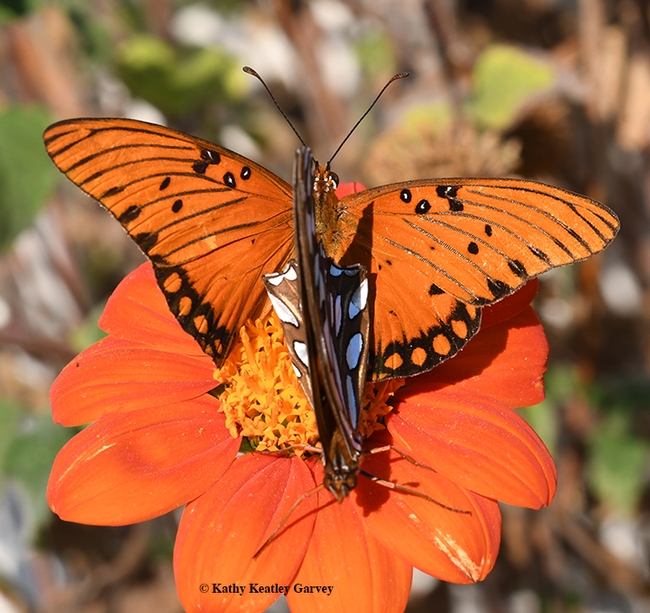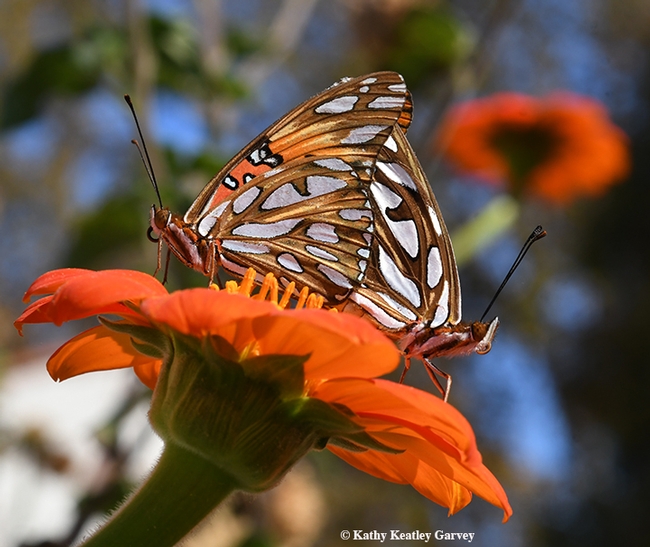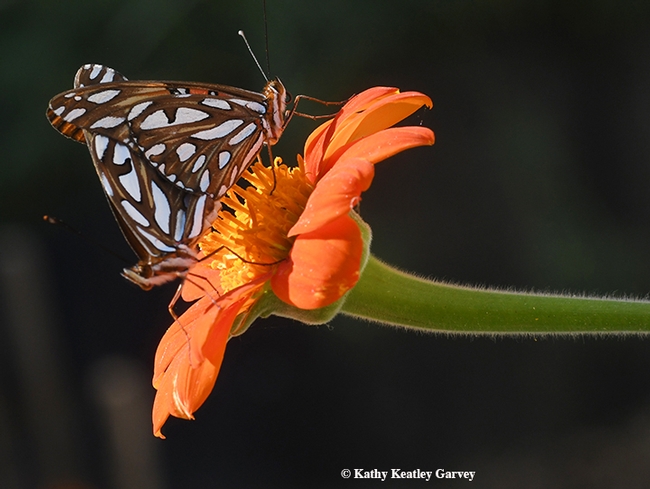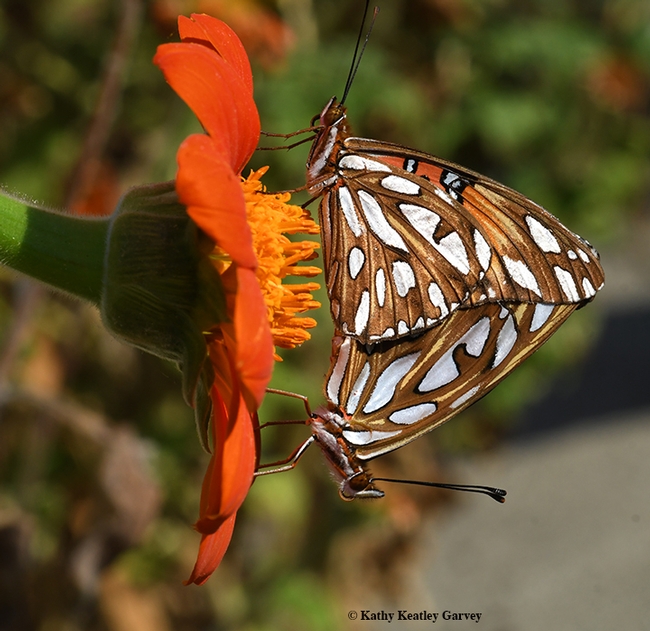- Author: Kathy Keatley Garvey
"More than beautiful, monarch butterflies contribute to the health of our planet. While feeding on nectar, they pollinate many types of wildflowers.--National Park Service.
Have you ever seen pollen on a monarch butterfly?
This morning a male migrating monarch, probably on its way to coastal California to an overwintering site, stopped at a Vacaville garden to sip some nectar on a Mexican sunflower (Tithonia rotundifola).
If you look closely, you can see the gold pollen.
Monarchs are not just iconic species facing a population decline, they're pollinators.
"Pollinator species, such as bees, other insects, birds and bats play a critical role in producing more than 100 crops grown in the United States," according to the U.S. Department of Agriculture. "Honey bee pollination alone adds more than $18 billion in value to agricultural crops annually."
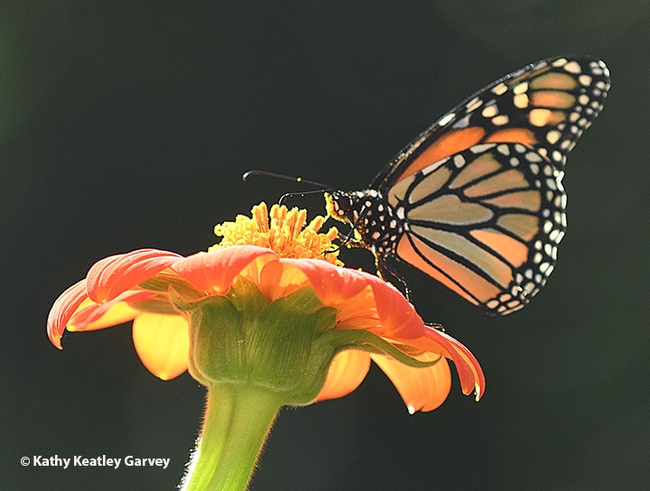
- Author: Kathy Keatley Garvey
In his fascinating book, "Life on a Little-Known Planet: A Biologist's View of Insects and Their World," Connecticut-born biologist/entomologist Howard Ensign Evans (1919-2002) asks "What good is a butterfly?"
"To the farmer, it is an adult cabbage worm or carrot caterpillar, and better off dead. To the entomologist, it is a member of a group of diurnal lepidopterans possessing knobbed antennae, a group containing a few pest species but mainly of interest to hobbyists and dabblers. To the romantic poet, it is a stray piece of some forgotten rainbow, a vagrant wisp of eternity---but there are no longer any romantic poets to speak of. To the man of the world, the pillar of society, a butterfly is simply nothing at all."
Oh, but they bring waves of joy to gardeners. And they are pollinators!
Take the Gulf Fritillaries or passion butterflies (Agraulis vanillae) that breed on our passionflower vine (Passiflora), sip nectar from a zinnia, and flutter around the garden as if they own it. They do. It is their real estate.
Sometimes the Gulf Frits encounter a bird, a praying mantis or a spider, and sometimes they live to bring us another wave of joy. Maybe a ripple, maybe a swell, maybe a surge...but it's a wave of joy.
Thank you, Gulf Frits!
And thank you, Howard Ensign Evans, for describing them as "a stray piece of some forgotten rainbow, a wisp of eternity."
Because they are.
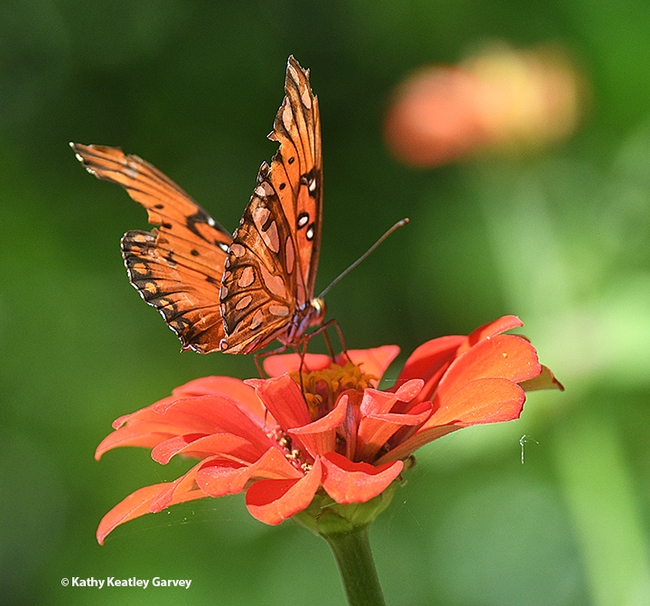
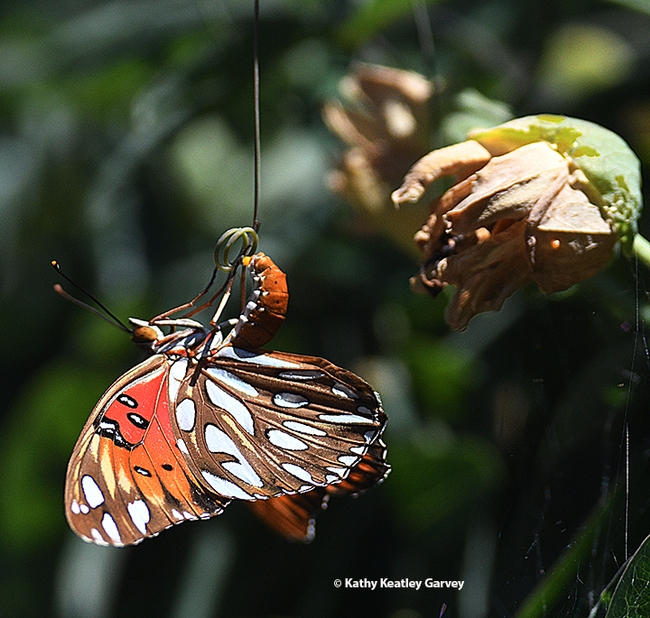
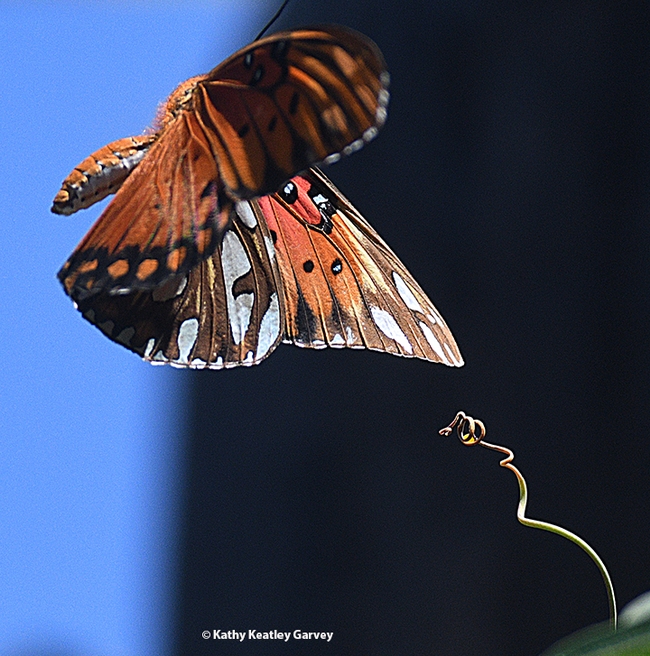
- Author: Kathy Keatley Garvey
Okay, boys, listen up!
You're the Lucky Seven!
Count yourselves. There are seven of you--seven male Melissodes agilis bees--sleeping on a single spent Mexican sunflower blossom (Tithonia rotundifola).
Do you know how lucky you are?
No, not that you escaped the hungry flameskimmer dragonfly patrolling the yard on July 7. Or the cunning spider building its web.
You're the Lucky Seven!
Forget the Seven Deadly Sins, Snow White and the Seven Dwarfs, Seven Wonders of the World, Seven Seas, Seven Continents and Seven Days of the Week. Forget about Willie Nelson singing "Seven Spanish Angels." Forget about the time that George Constanza suggested a baby be named "Seven" in Season 7 of Seinfeld. See? Seven. Season 7. Seinfeld.
Yes, fellas, you "bee" the Lucky 7.
Your cluster grew to seven last night as you slumbered away on Cloud Nine, no predators in sight.
Seventh Heaven!
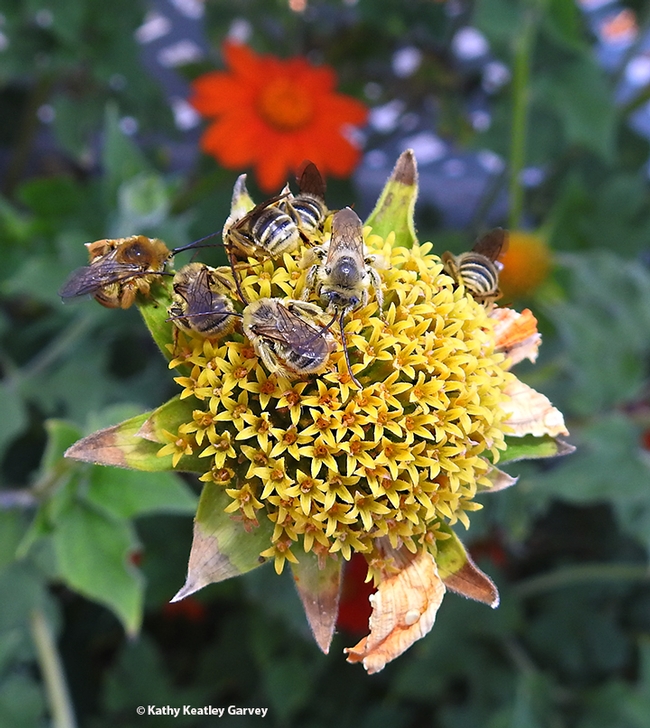
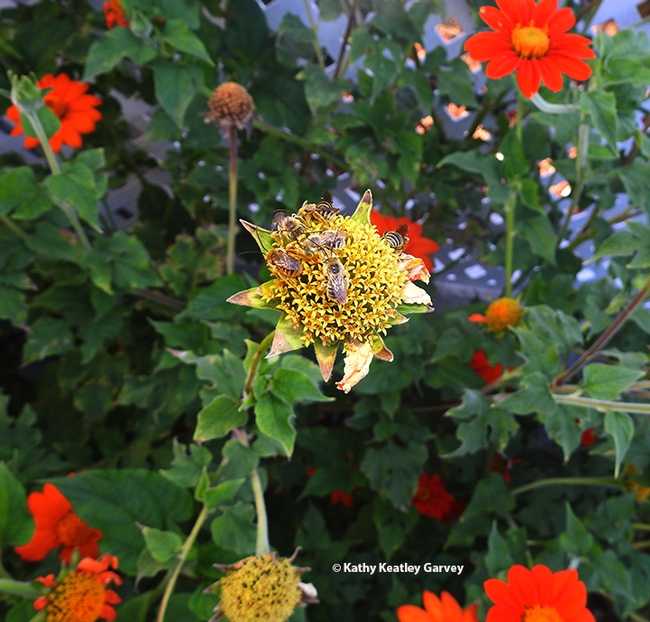
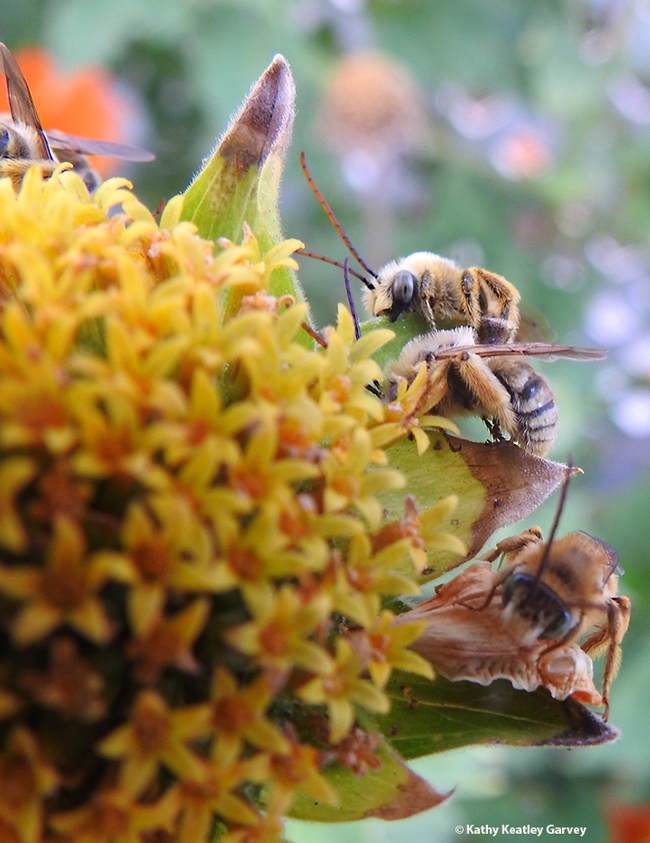
- Author: Kathy Keatley Garvey
Have you ever seen a bumble bee sleeping?
If you slip out to your garden at night or early morning, you might find the male bumble bees asleep in, on or around the flowers.
The yellow-faced bumble bee, Bombus vosnesenskii, frequents our pollinator garden in Vacaville, Calif. By day, the bumble bees nectar on African blue basil, Mexican sunflower, lavender, salvia, foxgloves, catmint, honeysuckle, milkweed, California golden poppies and the like. Then at night, when the females return to their nests, the males find a cozy place to sleep.
They may cushion their heads on a Mexican sunflower (Tithonia) or straddle a lavender (Lavendula), holding on with their legs or mandibles.
Oftentimes they'll sleep safely and securely inside a flower that closes at night, such as a California poppy or a torch cactus.
Our Bombus residents seem to prefer the Mexican sunflowers and lavender.
Nighty-night. Sleep tight. Don't let the praying mantids and spiders bite.
Bee Books
Interested in bumble bees? Be sure to read the landmark book, California Bees and Blooms: A Guide for Gardeners and Naturalists (Heyday Press). the work of UC-affiliated authors Gordon Frankie, (the late) Robbin Thorp, Rollin E. Coville, and Barbara Ertte.
Thorp (1933-2019), a distinguished emeritus professor with the UC Davis Department of Entomology and Nematology, also co-authored Bumble Bees of North America: An Identification Guide (Princeton University Press).
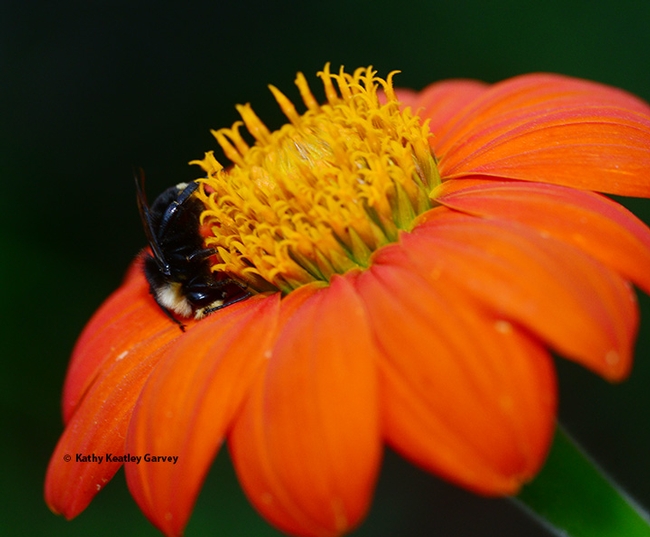
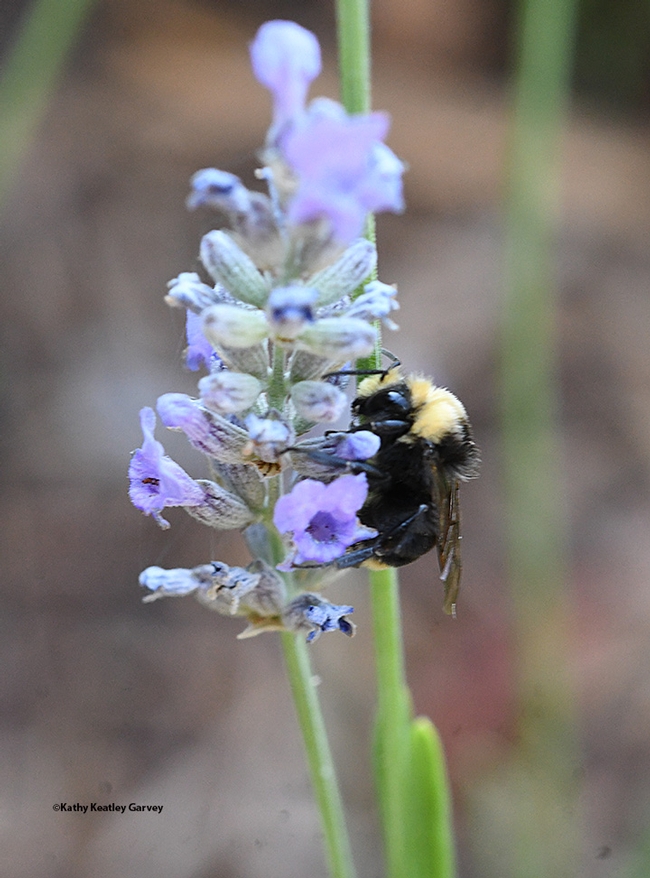
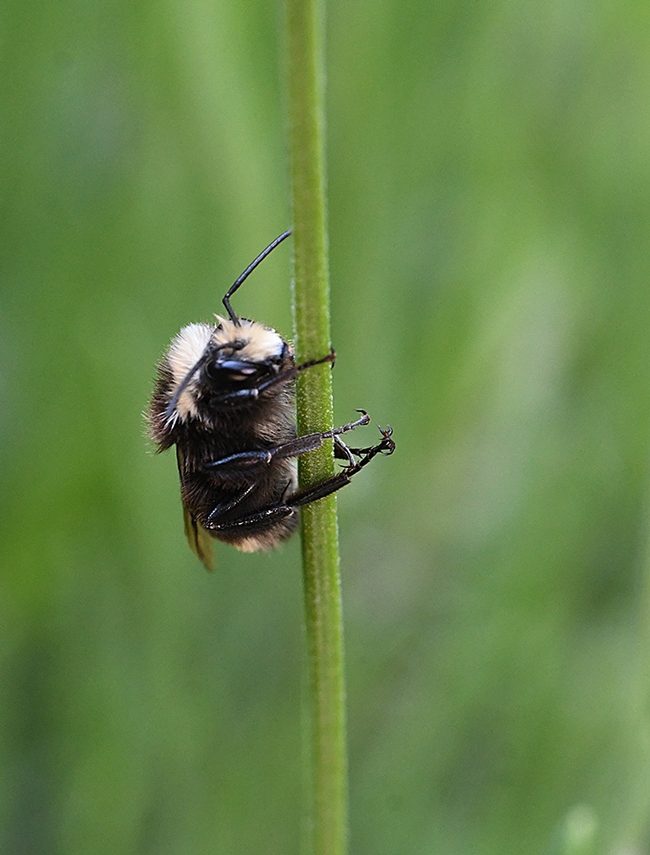
- Author: Kathy Keatley Garvey
Love is like a butterfly
A rare and gentle thing
--Love Is Like a Butterfly, Dolly Parton
When Dolly Parton penned her song, "Love Is Like a Butterfly," she probably wasn't thinking of passion butterflies, Gulf Fritillaries.
And when she sings that popular song, neither she nor her audience are thinking of Gulf Fritillaries (Agraulis vanillae), getting together on a Mexican sunflower, Tithonia rotundifolia.
But Lepidopterists, entomologists, horticulturists and insect photographers are.
It's autumn, approaching Halloween, and the Gulf Fritillaries are doing what comes naturally on their host plant, the passionflower vine. But sometimes you'll find them on the fence line, on the ground, or on a neighboring flower.
Then you make a beeline for your camera. It's insect wedding photography. The bride and the groom and the photographer. The sun is shining, the birds are singing, the flowers are producing nectar, the bees are buzzing, the crickets are chirping, and all's right with the world.
Love is indeed like a butterfly, "a rare and gentle thing."
